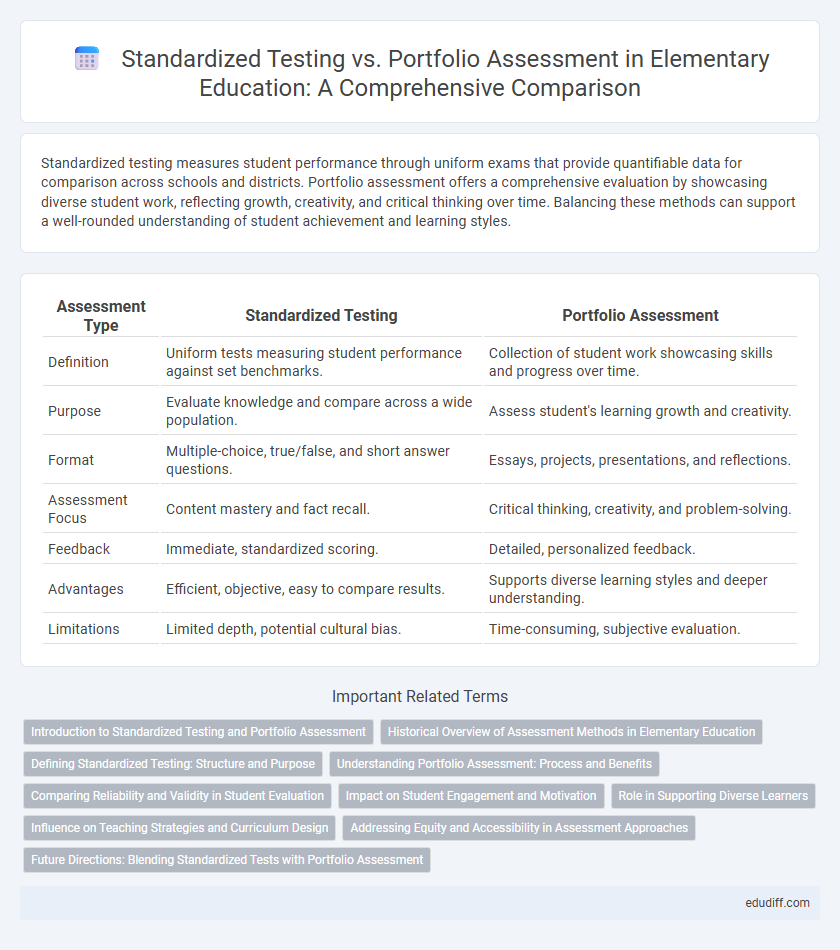Standardized testing measures student performance through uniform exams that provide quantifiable data for comparison across schools and districts. Portfolio assessment offers a comprehensive evaluation by showcasing diverse student work, reflecting growth, creativity, and critical thinking over time. Balancing these methods can support a well-rounded understanding of student achievement and learning styles.
Table of Comparison
| Assessment Type | Standardized Testing | Portfolio Assessment |
|---|---|---|
| Definition | Uniform tests measuring student performance against set benchmarks. | Collection of student work showcasing skills and progress over time. |
| Purpose | Evaluate knowledge and compare across a wide population. | Assess student's learning growth and creativity. |
| Format | Multiple-choice, true/false, and short answer questions. | Essays, projects, presentations, and reflections. |
| Assessment Focus | Content mastery and fact recall. | Critical thinking, creativity, and problem-solving. |
| Feedback | Immediate, standardized scoring. | Detailed, personalized feedback. |
| Advantages | Efficient, objective, easy to compare results. | Supports diverse learning styles and deeper understanding. |
| Limitations | Limited depth, potential cultural bias. | Time-consuming, subjective evaluation. |
Introduction to Standardized Testing and Portfolio Assessment
Standardized testing in elementary education involves uniform assessments that measure students' knowledge against specific benchmarks using multiple-choice or short-answer formats. Portfolio assessment compiles students' work over time, showcasing their progress through essays, projects, and creative assignments, emphasizing growth and individualized learning. Both methods aim to evaluate student achievement but differ in format, purpose, and the type of data collected for educational decisions.
Historical Overview of Assessment Methods in Elementary Education
Standardized testing in elementary education emerged in the early 20th century as a method to objectively measure student achievement using uniform exams like the Iowa Test of Basic Skills. Portfolio assessment gained prominence in the late 20th century, emphasizing student work samples and growth over time to provide a more comprehensive view of learning. Historical shifts reflect changing educational priorities from quantifiable benchmarks to holistic evaluation approaches in elementary classrooms.
Defining Standardized Testing: Structure and Purpose
Standardized testing is a method of evaluating student performance using uniform procedures and scoring to ensure consistency and comparability across different individuals and schools. These tests often include multiple-choice questions and are designed to measure specific academic skills and knowledge in areas such as math, reading, and science. The primary purpose is to provide objective data for assessing educational achievement, guiding instruction, and informing policy decisions.
Understanding Portfolio Assessment: Process and Benefits
Portfolio assessment in elementary education involves collecting student work over time to provide a comprehensive view of learning progress and skills development. This process encourages reflective thinking, self-assessment, and personalized feedback, which supports deeper understanding and critical thinking. Benefits include showcasing a diverse range of student abilities and growth, promoting creativity, and reducing test anxiety often associated with standardized testing.
Comparing Reliability and Validity in Student Evaluation
Standardized testing offers high reliability through uniform procedures and scoring, enabling consistent comparison across diverse student populations. Portfolio assessment enhances validity by providing a comprehensive view of student skills and learning progress over time, reflecting individual creativity and critical thinking. Balancing reliability and validity requires recognizing that standardized tests measure specific knowledge efficiently, while portfolios capture broader competencies and contextual understanding.
Impact on Student Engagement and Motivation
Standardized testing often limits student engagement by emphasizing rote memorization and test-taking skills rather than creative thinking, reducing intrinsic motivation. Portfolio assessment enhances student motivation by allowing learners to showcase diverse skills and reflect on their progress, promoting active participation and personalized learning. Research indicates portfolios foster deeper engagement through continuous feedback and self-expression, supporting sustained academic enthusiasm in elementary students.
Role in Supporting Diverse Learners
Standardized testing offers measurable benchmarks to identify learning gaps among diverse elementary students, ensuring consistent evaluation across different demographics. Portfolio assessment provides a comprehensive view of individual progress by showcasing students' unique strengths, creativity, and development over time. Combining both methods supports inclusive education by addressing varied learning styles and promoting personalized growth.
Influence on Teaching Strategies and Curriculum Design
Standardized testing drives teachers to prioritize test-related content and skills, often narrowing curriculum focus to meet specific benchmarks. Portfolio assessment encourages educators to design more diverse and student-centered learning experiences, fostering creativity and critical thinking. This approach promotes continuous feedback and adaptable teaching strategies aligned with individual student growth.
Addressing Equity and Accessibility in Assessment Approaches
Standardized testing often presents challenges for equity and accessibility due to cultural biases and limited accommodations for diverse learning needs. Portfolio assessment allows for a more individualized evaluation by showcasing a student's unique skills and progress over time, accommodating different learning styles and backgrounds. Incorporating portfolio assessments alongside standardized tests can help create a more inclusive and fair measurement of elementary students' abilities.
Future Directions: Blending Standardized Tests with Portfolio Assessment
Blending standardized tests with portfolio assessment offers a balanced approach to evaluating elementary students' progress by combining quantitative data with qualitative insights. This integration allows for more personalized learning experiences and supports diverse learning styles while maintaining metrics for accountability. Future directions emphasize using technology to streamline portfolio collection, enabling real-time feedback alongside standardized test results for comprehensive student evaluation.
Standardized Testing vs Portfolio Assessment Infographic

 edudiff.com
edudiff.com